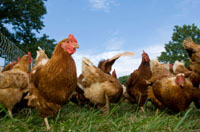Can I keep chickens in woodland?

Free-range poultry is a popular choice among shoppers, with many consumers choosing to go free-range for ethical and environmental reasons. Some people are going one step further, rearing their own free-range chickens in their back gardens or woodlands. Although they require daily care, chickens can be less demanding than dogs or cats and are surprisingly easy to rear.
Chickens can be kept in urban areas, but are believed to be at their happiest in open, wooded areas. They spend much of their time in the shade – an instinct thought to date back to their origins as ‘jungle fowl’ hiding under trees to evade predators. Woodlands are ideal environments for chickens, providing them with shade, shelter and space to roam.
Well-treated chickens are said to produce better quality eggs and meat than those kept in captivity, with some people claiming they can immediately spot the difference in taste between a free-range hen egg and that of a battery hen.
Chickens flourish in the open air and should be given plenty of space. Although they can only flutter, chickens love to run around and scratch for their own food. They can subsist on a diet of insects, grass seeds and weeds, and are well suited to rough, grassy areas where they can dig and search for food.
Chickens’ appetite for slugs and insects can help to keep pests at bay in a garden. However, they can disturb the woodland floor by creating mud baths to relieve themselves of parasites.
Your chickens may be targeted by hungry predators, and you might want electric fencing to deter them. Rabbit-proof fencing to prevent chickens from roaming is essential, and they will appreciate a hen house with a ramp, wooden roof, hatch and lighting. Alternatively, an old farm building or shed can provide a safe sleeping space.
Any advice you can add on keeping chickens?
Comments are closed for this post.
Discussion
I would imagine a chicken shed would need planning permission just like a normal shed. Best to ask your local council
Hi Neil
There is a bit of a discussion going on the Small woodland owners group forum about this, that you might find useful
http://www.swog.org.uk/forum/topic.php?id=408
ps would be hopeing to keep about 50?
Hi , I have also been wonering about this, as I hope to find a small wood in the next year or so, can anyone tell me if there are any laws that would stop me keeping a hut designed for hens,it would be on skids and moved a few times a year?
I would fence off an erea to keep them safe when outside, are there any maximum dimentions to a structure like this?
thanks for any advice, Neil

I’ve kept chickens myself in a semi-wooded area. Planning permission is needed only if the shed is over a certain size, you can get smaller coops suitable for housing anything from 3 to 30 chickens in all different shapes and sizes.
Overgrazing can be a problem if you keep too many chickens since they eat all the “greens” they can find and if they run out of other sources they’ll eat the grass as well. They also scratch at the ground and dig at it to find insects and worms.
The part about the dust baths chickens take isn’t really a major issue, chickens dig a small string of holes, usually somewhere with dusty, dry soil and dust themselves in it which helps eliminate fleas and mites. They often dust bathe under sheds and at the side of fences since chickens don’t like open spaces as much (as already mentioned the wild chickens, Red Junglefowl are a creature which lives in the cover of jungles – forests).
Chickens like some shrubs for cover or trees but smaller breeds of bantams are better fliers and although they can only fly onto branches and not actually fly away they can roost in trees and get over fences if their wings aren’t clipped, although for medium to larger breeds this isn’t usually a problem.
Chickens wonder around forest floors and naturally roost in trees at night away from predators.
To get them to return to the coop every night you should leave them in it for the first week or so for them to establish it as being a safe place for them to roost in and then they should return to it every night after that, but don’t forget to shut the doors once they’re in! (foxes, stoats, weasels on the prowl!).
Chickens scratching at the woodland floor can help establish new growth in flowers and shrubs so long as an area isn’t overgrazed but they will also eat at young shoots.
When I formerly had land with a few chickens would wonder upto the hedgerows and under an oak tree to dust bath and have a peck around in. I also found feral chickens on many occasions running wild in a nearby wood, another shooting wood is located near to it with Pheasant breeding pens so no guesses for where they were finding food!
If anyone decides to keep them in woods I’d suggest a shaded area, but with a good amount of sunlight as well and an area with already rather bare land or a place covered with leaves, soil or old rotting bark. Some people in towns put down bags of bark for chickens to sort through and find grubs in, this is a good idea if you can provide it. I’d suggest a decent sized run with a few trees, shrubs and with some bark, dead wood and soil areas in it.
Don’t place a coop where it could flood and put it on breeze blocks or railway sleepers since this discourages rats to build nests under it and keeps the shed floor from getting wet and eventually rotten.
Andrew
2 January, 2011